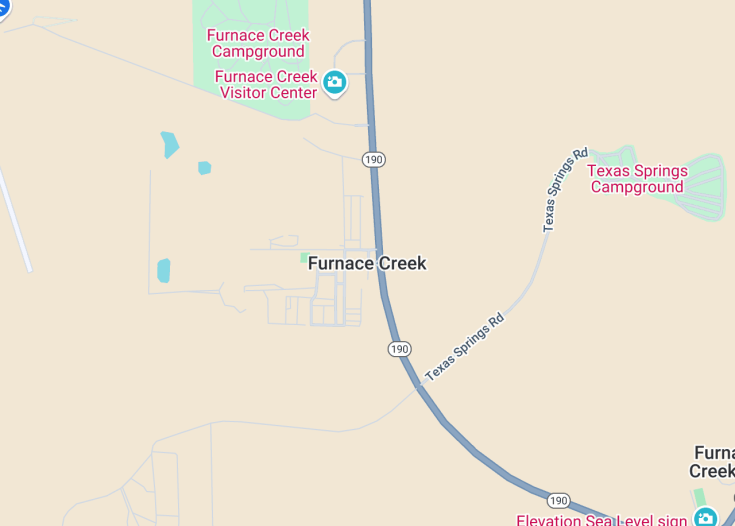Nestled in the vast and striking landscape of Death Valley National Park, Furnace Creek serves as a pivotal exploration hub for visitors. This oasis in the desert offers a unique blend of natural wonders and historical sites, including the lowest point in North America at Badwater Basin and the intriguing Harmony Borax Works.
The area provides an excellent base for exploring the park’s otherworldly terrains, dramatic salt flats, and ancient geological formations. With its rich mining history and captivating scenic drives, Furnace Creek is an essential stop for those seeking to uncover the mysteries of one of the hottest places on Earth.
Plan your visit during the cooler months from November to March to avoid the extreme summer temperatures, which can be overwhelming.
Ensure to carry ample water and sun protection, as the arid climate and soaring temperatures can pose a health risk during outdoor activities.
Top things to do & see in Furnace Creek
Select the following sights and activities to discover best tickets and tours available in Furnace Creek.
Furnace Creek: An Oasis in the Desert
| Country | California (USA) |
| Time in Furnace Creek | GMT-8 |
| Language spoken | English |
| Population | 24 (Source: Latest Census Data) |
| Currency | US Dollar (USD $) |
| Airports |
|
Furnace Creek, located in the heart of Death Valley, California, boasts a unique blend of natural beauty and stark, arid landscapes. As one of the hottest places on Earth, it offers visitors a chance to experience unparalleled desert vistas.
While primarily known for its extreme temperatures, this tiny village is surrounded by some of the most striking geological features in North America. From salt flats to sand dunes, and mountains painted with a palette of mineral-induced colors, the scenery is both otherworldly and breathtaking.
Where is Furnace Creek?
Furnace Creek sits in Death Valley National Park, in eastern California, known for its extreme heat and scenic desert views.
Distances:
| Route | Distance by car | Time by car |
|---|---|---|
| From Los Angeles | 230 mi | 4 hours |
| From Las Vegas | 120 mi | 2 hours |
| From San Francisco | 415 mi | 6.5 hours |
What is Furnace Creek famous for?
Furnace Creek is renowned for its dramatic desert landscapes and as the hottest place on Earth. It serves as a vibrant hub within the expansive and mesmerizing Death Valley National Park.
History
Pre-20th Century
Originally known as the land of the Timbisha Shoshone Native Americans, Furnace Creek’s geographical and cultural landscape was immensely shaped by this indigenous group. The region served as a winter camp for these Native Americans, who exploited the area’s resources, particularly the native mesquite trees for their beans and the small creeks throughout the valley for water. It wasn’t until the late 19th century that Furnace Creek saw an influx of settlers due to mining prospects, following the discovery of Borax. Notably, it remained relatively remote and difficult to access until significant developments in the early 20th century.
Early 20th Century
During the early 1900s, Furnace Creek experienced a transformative period due to borax mining. The famous 20-mule teams hauling borax out of the valley is a key piece of this era’s history. In 1927, the establishment of Furnace Creek Inn marked a significant shift from a mining hub to a potential tourist destination, oriented towards leveraging the extreme landscape for leisure and tourism. As mining dwindled, tourism slowly emerged as the primary economic activity, showcasing the stark beauty of Death Valley.
Late 20th Century to Present
The latter part of the 20th century through to the present day has seen Furnace Creek evolve into a major tourist attraction within Death Valley National Park. Furnace Creek Ranch was developed into a resort to accommodate an increasing number of visitors. Conservation efforts were amplified to protect the natural and cultural heritage of the area. Today, it stands as a testament to both the harshness and allure of Earth’s natural extremities, drawing visitors globally who come to experience its unique environment and historical sites.
Visit Furnace Creek
What to see and do in Furnace Creek, California (USA)
Furnace Creek serves as a gateway to the natural and historic treasures of Death Valley National Park. Visitors can explore the Furnace Creek Visitor Center, which offers informative exhibits about the area’s geology and ecology.
Hiking opportunities abound, with trails such as Golden Canyon and the Salt Creek Trail showcasing the park’s geological features and wildlife.
- Experience the heat at the Furnace Creek area, known for some of the highest temperatures on Earth.
- Visit the historic Harmony Borax Works, a key site in the borax mining history.
- Engage in star gazing sessions, as the clear skies and minimal light pollution provide optimal conditions for astronomy enthusiasts.
Annual Events in Furnace Creek
Furnace Creek is host to a variety of events throughout the year, particularly notable are the Death Valley ’49ers Encampment and the Badwater Ultramarathon.
The ’49ers Encampment, held in November, commemorates the historic wagons of gold seekers, while the Badwater Ultramarathon in July, is known as one of the world’s toughest foot races, covering 135 miles from Death Valley to Mt. Whitney.
Best time to visit Furnace Creek
The optimal time to visit Furnace Creek is during the cooler months from October to April. This period avoids the extreme summer temperatures that can reach up to 120 degrees Fahrenheit, making outdoor activities more pleasant and safe.
Is Furnace Creek worth visiting?
Indeed, Furnace Creek is well worth a visit for those intrigued by natural extremities and rich history. As part of Death Valley, it offers a unique blend of stark beauty, extreme climates, and significant historical sites.
The transformation from a mining outpost to a tourist haven is a compelling story of adaptation and survival, resonating deeply with those who explore this extraordinary landscape.










